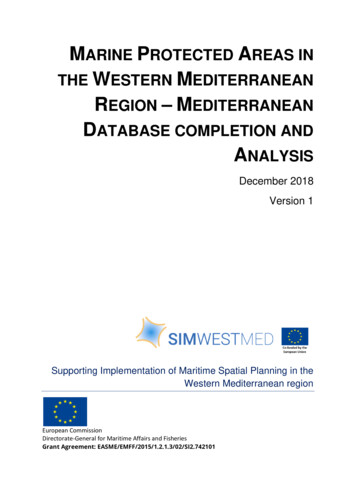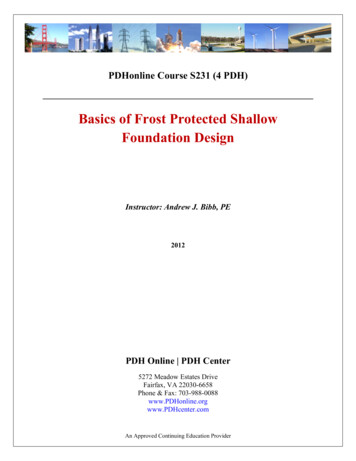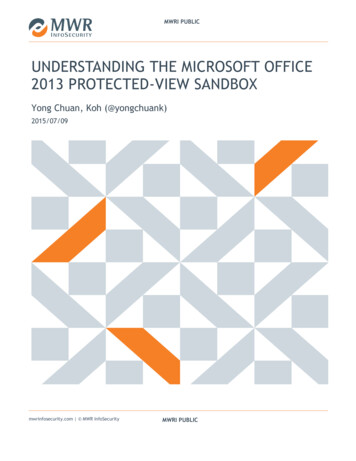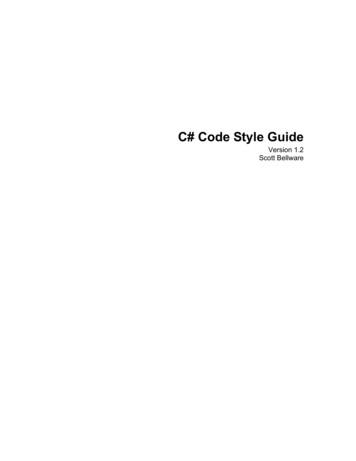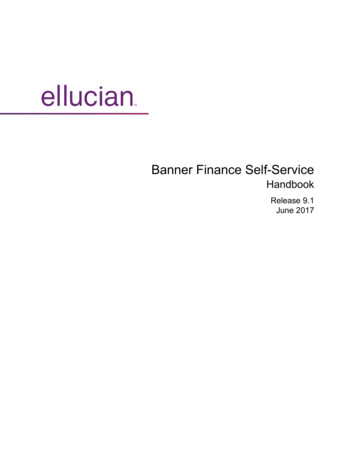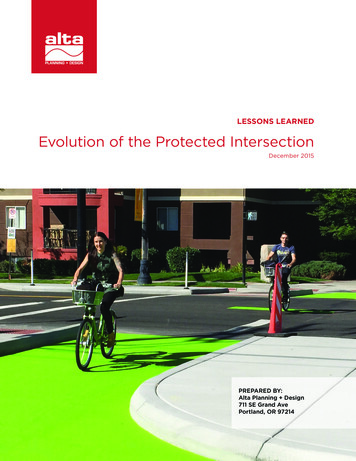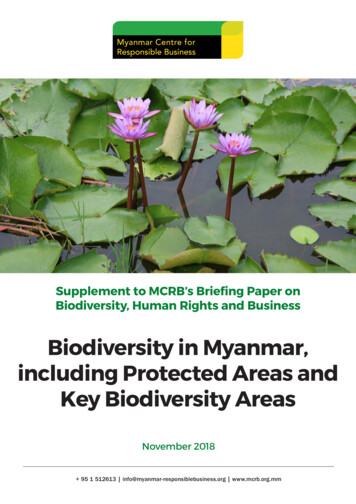
Transcription
This Document is Protected by copyright and was first published by Frontiers. All rights reserved. It isreproduced with permission.
ORIGINAL RESEARCHpublished: 24 May 2016doi: 10.3389/fmicb.2016.00769A Game of Russian Roulette for aGeneralist Dinoflagellate Parasitoid:Host Susceptibility Is the Key toSuccessElisabet Alacid 1*, Myung G. Park 2 , Marta Turon 3 , Katherina Petrou 4 and Esther Garcés 11Departament de Biologia Marina i Oceanografia, Institut de Ciències del Mar – Consejo Superior de InvestigacionesCientíficas, Barcelona, Spain, 2 Laboratory of HAB Ecophysiology, Department of Oceanography, Chonnam NationalUniversity, Gwangju, South Korea, 3 Departament d’Ecologia Aquàtica, Centre d’Estudis Avançats de Blanes, ConsejoSuperior de Investigaciones Científicas, Blanes, Spain, 4 School of Life Sciences, University of Technology Sydney, Sydney,NSW, AustraliaEdited by:Télesphore Sime-Ngando,Centre National de la Recherche,FranceReviewed by:Chambouvet Aurelie,Centre National de la Recherche,FranceDeborah Jane Macarthur,Australian Catholic University,Australia*Correspondence:Elisabet Alacidalacid@icm.csic.esSpecialty section:This article was submitted toAquatic Microbiology,a section of the journalFrontiers in MicrobiologyReceived: 21 March 2016Accepted: 06 May 2016Published: 24 May 2016Citation:Alacid E, Park MG, Turon M, Petrou Kand Garcés E (2016) A Gameof Russian Roulette for a GeneralistDinoflagellate Parasitoid: HostSusceptibility Is the Key to Success.Front. Microbiol. 7:769.doi: 10.3389/fmicb.2016.00769Marine microbial interactions involving eukaryotes and their parasites play an importantrole in shaping the structure of phytoplankton communities. These interactions mayalter population densities of the main host, which in turn may have consequences forthe other concurrent species. The effect generalist parasitoids exert on a community isstrongly dependent on the degree of host specificity. Parvilucifera sinerae is a generalistparasitoid able to infect a wide range of dinoflagellates, including toxic-bloom-formingspecies. A density-dependent chemical cue has been identified as the trigger for theactivation of the infective stage. Together these traits make Parvilucifera-dinoflagellatehosts a good model to investigate the degree of specificity of a generalist parasitoid,and the potential effects that it could have at the community level. Here, we presentfor the first time, the strategy by which a generalist dinoflagellate parasitoid seeks outits host and determine whether it exhibits host preferences, highlighting key factors indetermining infection. Our results demonstrate that in its infective stage, P. sinerae isable to sense potential hosts, but does not actively select among them. Instead, theparasitoids contact the host at random, governed by the encounter probability rateand once encountered, the chance to penetrate inside the host cell and develop theinfection strongly depends on the degree of host susceptibility. As such, their strategyfor persistence is more of a game of Russian roulette, where the chance of survival isdependent on the susceptibility of the host. Our study identifies P. sinerae as a potentialkey player in community ecology, where in mixed dinoflagellate communities consistingof hosts that are highly susceptible to infection, parasitoid preferences may mediatecoexistence between host species, reducing the dominance of the superior competitor.Alternatively, it may increase competition, leading to species exclusion. If, however,highly susceptible hosts are absent from the community, the parasitoid populationcould suffer a dilution effect maintaining a lower parasitoid density. Therefore, both hostcommunity structure and host susceptibility will determine infectivity in the field.Keywords: Parvilucifera, dinoflagellates, perkinsids, host–parasite interactions, specificity, prevalenceFrontiers in Microbiology www.frontiersin.org1May 2016 Volume 7 Article 769
Alacid et al.P. sinerae Infection Strategy and Host Preferencesa host, the offspring are unable to produce a second generation(Coats and Park, 2002). Dinomyces and Parvilucifera species(with the exception of P. prorocentri) have been described asgeneralist parasitoids, able to infect a wide range of hosts withindinoflagellates, including toxic species (Garcés et al., 2013a;Lepelletier et al., 2014a,b). In the case of Parvilucifera parasitoids,although a generalist in terms of the number of species they areable to infect, intra and inter-species variability still exists at thelevel of host susceptibility or infectivity (Figueroa et al., 2008;Råberg et al., 2014; Turon et al., 2015). The extent to whichParvilucifera parasitoids show preferences for certain hosts hasnot been fully investigated. Further research is required in orderto understand the potential effects this parasitoid may have inmarine microbial communities.A system comprised of Parvilucifera sinerae and theirdinoflagellate hosts provides a good model to address whethergeneralists Parvilucifera parasitoids exhibit preferences for themost susceptible hosts available, given that, (i) the reproductivesuccess of the parasitoid depends on its ability to infect a host,(ii) it can infect a wide range of hosts from among dinoflagellates,and (iii) it uses chemical cues, such as dimethylsulfide, to detecthost presence (Garcés et al., 2013b). As such, the objectivesof the present work were to determine if P. sinerae showspreferences among possible dinoflagellate hosts, and evaluatewhether the host susceptibility or the host dominance (in termsof abundance), are decisive factors when the parasitoid infects ahost.INTRODUCTIONHistorically, the role of parasitic protists in marine planktonicecosystems has been largely neglected. New molecular tools haverevealed that parasitism is a widespread interaction in aquaticmicrobial communities with a high diversity of unclassifiedparasites (Lefèvre et al., 2008; de Vargas et al., 2015) evenin marine ecosystems not considered previously (Cleary andDurbin, 2016). There is increasing evidence that protist parasitesmay have a significant effect on plankton at the population,community, and ecosystem levels (Chambouvet et al., 2008;Lepère et al., 2008).Parasite-mediated effects on their host populations arestrongly dependent on parasitic specificity, i.e., the strength ofthe interactions between them (Anderson and May, 1981). Hostspecies differ in their susceptibility to a certain parasite; thereforeparasite transmission between species is often asymmetrical,where one host species might be highly infected resulting ina higher parasite load to the system (Woolhouse et al., 2001).In some host–parasite systems, generalist parasites infectingmultiple host species possess traits to discriminate amongsthost species (Krasnov et al., 2002; Goubault et al., 2004; Wangand Messing, 2004; Sears et al., 2012). Host abundance, speciesidentity or host susceptibility are characteristics suggested toinfluence parasite preferences for choosing a certain host toinfect in these systems, since these preferences are supposed tobe adaptive strategies that maximize parasite fitness. Given thathosts can vary in their susceptibility to a certain parasite, and thathost relative abundance in natural communities shift, parasiteselection amongst host species is a very relevant question that hasnot yet been explored in great detail in parasitoid–phytoplanktonsystems.Dinoflagellates are a dominant group of eukaryoticphytoplankton and an important component in marineecosystem functioning, playing a key role in primary productionand the marine food web (Margalef, 1978; Reynolds, 2006).Many dinoflagellate species can cause blooms and some ofthem produce potent toxins that cause negative impacts forhuman health, aquaculture and marine ecosystems (Zingoneand Enevoldsen, 2000). Currently, three groups of zoosporicparasitoids with different phylogenetic origin are known to infectdinoflagellates, ‘Amoebophrya ceratii’ complex (Syndiniales),Parvilucifera (Perkinsids) and Dinomyces (Chytrid), moreover,environmental molecular surveys have unveiled a high hiddendiversity amongst these groups (Guillou et al., 2008; Chambouvetet al., 2014). The characteristics of these parasitoids are to killtheir host, to have short generation times and to produce ahuge amount of offspring following host infection (Coats andPark, 2002; Garcés et al., 2013a; Lepelletier et al., 2014a),therebyreducing the abundance of their hosts, potentially alteringhost population processes, such as competition, which in turninfluence community composition.Several studies have evaluated the range and specificity inhost–parasitoid systems. In the case of the ‘Amoebophrya ceratii’complex, some clades are specialists (Chambouvet et al., 2008),whereas others have a broader host range (Coats and Park, 2002;Kim, 2006). However, in some generalist strains, after infectingFrontiers in Microbiology www.frontiersin.orgMATERIALS AND METHODSHost and Parasitoid CulturesExperiments were conducted with host strains of severaldinoflagellate taxa obtained from the culture collection of theCentro Oceanográfico (CCVIEO) in Vigo, Spain. Specifically,we used two strains belonging to Gonyaulacales: Alexandriumminutum (AMP4), and Protoceratium reticulatum (GC1AM); twostrains belonging to Gymnodiniales: Gymnodinium catenatum(GC11V), and Amphidinium carterae (ACRN03); and two strainsbelonging to Peridiniales: Scrippsiella trochoidea (S3V), andHeterocapsa niei (VGO 623).Cultures were maintained in 50 mL polystyrene tissue cultureflasks filled with 20 mL of L1 medium (Guillard, 1995) withoutsilica. The medium was prepared with filtered (0.2 µm),autoclaved seawater, adjusting the salinity to 31 by the additionof sterile MilliQ water. Cultures were grown at 20 1 C witha photoperiod of 12:12 h (light:dark) cycle. Illumination wasprovided by fluorescent tubes with a photon irradiance of about90 µmol photons m 2 s 1 .Stock parasitoid culture of P. sinerae (ICMB852) waspropagated by transferring a 1 mL aliquot of mature sporangiumevery 6–7 days into an uninfected host stock culture ofexponentially growing A. minutum strain AMP4 in sterilepolystyrene six well-plates, each well with a growth area of9.6 cm2 and a volume of 15.5 mL (BD Biosciences). These cultureswere maintained under the same culture conditions mentionedabove.2May 2016 Volume 7 Article 769
Alacid et al.P. sinerae Infection Strategy and Host PreferencesAmphidinium; see Table 2 of the study of Garcés et al., 2013a),we used this resistant species to know whether Parviluciferazoospores are attracted to dinoflagellates in general, both thosethat can be infected (susceptible) as well as those not in theirhost range (resistant or non-susceptible). We also tested theattractiveness of two infochemicals, dimethylsulfide (DMS)and dimethylsulfoniopropionate (DMSP), which are relatedto dinoflagellate metabolism and were previously identified aschemical signals that activated the release of the zoospores fromthe dormant sporangium (Garcés et al., 2013b). Each selectionchamber consisted of four 5 mL-syringes placed vertically,separated by 1 cm, into a 17-mL well volume (6-deep well plates,BioCoatTM ) containing 15 mL of L1 medium (n 9). In each ofthe nine wells, three of the syringes contained 1.5 mL of exudatesfrom A. minutum, H. niei, and A. carterae, while the fourthsyringe contained L1 medium (control). Exudates were preparedby filtering 5 mL of the host culture at 104 cells mL 1 through0.22-µm pore size Swinnex filters (Millipore) right before theexperiment. Then, we added 1 mL of swimming zoospores at aconcentration of 5 104 in the center of the well and syringesremained dipped for 30 min. After this period, syringes wereremoved and the whole content inside the syringe was fixedwith formaldehyde (1% final concentration). The number ofzoospores that entered inside the syringe was estimated bycounting at least 400 cells using a Sedgewick-Rafter chamberunder light microscopy. To test whether the zoospores wereattracted to specific chemicals cues, triplicate syringes containinglab-prepared DMS and DMSP at a concentration of 300 nMwere placed inside a well filled with L1 medium and 5 104swimming zoospores. After 30 min, syringes were removed andzoospores were counted as above.All experiments were conducted in triplicate using hostcultures growing exponentially and recently formed sporangiumof P. sinerae culture (strain ICMB 852). To obtain recently formedsporangia, 4 days after infection of an A. minutum (AMP4)culture, sporangia produced from the subsequent parasitegeneration were harvested for the inoculation of the experiments.Sporangia concentration was estimated by counting at least300 mature sporangia (late sporocyte) using a Sedgewick-Rafterchamber. Zoospore concentration was estimated by multiplyingthe number of zoospores contained in a single sporangium (250in the case of A. minutum; Garcés et al., 2013a) by the sporangiaconcentration. For the experiments, the volume added fromthe parasitoid mother culture was adjusted to obtain the finalzoospore concentration required in each of the experiments.Parasitoid Generation Time andTransmission in the Different HostPopulationsFor each host species, triplicate 30 mL cultures at initial density of1 104 mL 1 were inoculated with recently formed sporangia atzoospore: host ratio of 1:60. We used this low parasitoid ratio tomimic the initial phase of an epidemic, avoiding killing the entirehost population in the first generation, and then obtain two tothree parasitoid generations in the same host population.Infected cultures were performed in 50 mL-polystyrene tissueculture flasks, and incubated under growth conditions (describedabove) for 14–16 days. This incubation time was required toobserve at least two parasitoid generations depending on thehost species that was infected. We took a 1 mL aliquot daily,preserved it with formaldehyde (1% final concentration) andthe mature sporangia abundance were counted by invertedlight microscopy (Leica–Leitz DMIRB) using a Sedgewick-Rafterchamber by scoring at least 300 sporangia, with the exception ofthe first generation, where the infections where very low. Maturesporangia (late sporocyte) of each host species can be seen inFigure 1.Generation time was estimated by following the evolution ofinfected cells over time, which showed clear peaks associatedwith each parasitoid generation. We decomposed the evolutionfor each species into a sum of Gaussian peak shapes using anunconstrained non-linear optimization algorithm based on aniterative least-squares method, where the fraction of infected cellsis the division of each individual Gaussian peak shape by thetotal number of infected cell at each time step. This fraction dataallowed us to calculate the parasitoid generation time, followingan adaptation of the methodology of Carpenter and Chang (1988)for the quantification of parasitoid generation time, by knowingthe fraction of infected cells for each generation.Parasitoid Preferences for Host SpeciesParasitoid preferences for infecting certain host species inan artificial mixed community of A. minutum, S. trochoidea,P. reticulatum, H. niei, and G. catenatum was tested in triplicate.The initial host concentration of each species was normalized byhost cell biovolume in order to obtain a zoospore:host ratio of1:1 taking into account the biovolume of 1.5 103 G catenatumcells mL 1 which is the largest host. As the sizes of the hostspecies used in this experiment vary, normalization by host cellbiovolume avoids having different encounter probability ratesbetween the parasitoid and the host. Infected cells of each specieswere counted during the first 3 days after parasitoid addition.We counted at least 300 cells as either infected or uninfected,identifying the infected ones of the whole artificial communityby optical microscopy using a Sedgewick-Rafter chamber. Clearidentification of the infected species was obtained, as infection iseasily recognizable in the host species (Figure 1 column 2: earlytrophocyte).Host Selection ExperimentSusceptibility of Host SpeciesSelection chambers were used to determine whether Parviluciferazoospores demonstrated a putative behavioral attractionamong three dinoflagellate species: the high-susceptible hostA. minutum, the low-susceptible host H. niei, and the nonsusceptible host A. carterae. Since, A. carterae is a dinoflagellatebut not a potential host (Parvilucifera is not able to infectFrontiers in Microbiology www.frontiersin.orgParasitoid prevalence in the five host species used in thepreference experiment was determined as a function of inoculumsize. For each experiment, sets of triplicate 50 mL-polystyrenetissue culture flasks containing 20 mL of host cells at initialdensity of 5 103 mL 1 were inoculated with recently formed3May 2016 Volume 7 Article 769
Alacid et al.P. sinerae Infection Strategy and Host PreferencesFIGURE 1 Optical micrographs of the different life-cycle stages of Parvilucifera sinerae infecting five dinoflagellate hosts. Scale bar 20 µm.sporangia and incubated for 3–4 days under the same growthconditions as described above. Inoculum size of parasitoid foreach set of triplicate vials was adjusted to give zoospores: hostratios of 1:1, 2:1, 5:1, 10:1, 20:1, 40:1, and 80:1. In two hostspecies (H. niei and G. catenatum) the prevalence curve was notstabilized at ratio of 80:1, so we also inoculated both specieswith an inoculum size of 120:1 ad hoc. The time required todetect easily if the cell was infected or not was 3–5 days ofincubation and that time was shorter than the time needed forthe parasitoid to initiate a second round of infection (a secondgeneration) according to the results obtained in the generationtime experiment. After incubation, samples were preserved withformaldehyde (1% final concentration) and examined by invertedlight microscopy (Leica–Leitz DMIRB) to estimate parasitoidprevalence. Parasitoid prevalence was calculated as a percentageof infected cells and was determined by scoring at least 300 cellsper sample as infected (taking into account any of the infectionstages) or uninfected (healthy) in a Sedgwick-Rafter chamber.Frontiers in Microbiology www.frontiersin.orgData for each host species were fitted to a single two parameterexponential rise to maximum following the method of Coats andPark (2002). The equation for the curve fit was y a (1 – e bx ),where a is the maximum infection level (Imax ) and b is α/Imax .Alpha (α) represents the slope of the initial linear portion of thefitted curve and reflects the potential of zoospores to infect hostcells. Alpha was estimated as Imax b.Host Abundance ExperimentThe effect of host abundance on parasitoid preferences wasassessed in two systems; System A a mixed culture comprisedof two species that were equally preferred in the preferenceexperiment, A. minutum and S. trochoidea, and System B, amixed culture containing a preferred host, A. minutum and aless preferred host, H. niei. For each system, we establish aset of triplicates in 50 mL-culture flasks of varying dominancewith (i) the two hosts at the same initial host cell concentration(103 cells mL 1 ); (ii) a mixed culture with A. minutum and4May 2016 Volume 7 Article 769
Alacid et al.P. sinerae Infection Strategy and Host Preferenceshost concentration of 104 cells mL 1 , produced an increasednumber of mature sporangia over the 16 days, showing threepeaks corresponding to three generations of parasitoid life-cycle(Figures 2A–D). The same inoculation of G. catenatum resultedin a more gradual increase of the mature sporangia, showing onlytwo peaks during the same time period (Figure 2E).The estimated time for the first generation of P. sineraewas 62 and 137 h for the second generation in A. minutum(r2 0.98), being the species with the shortest generation time(Figure 2A). In the case of parasitoid infection in Scrippsiellatrochoidea (r2 0.99; Figure 2B) and P. reticulatum (r2 0.92;Figure 2D) the averaged generation time was the same forboth species, being 72 and 132 h for the first and the secondgenerations, respectively. Infecting H. niei (r2 0.93; Figure 2C),the parasitoid showed a generation time of 108 and 154 h for thefirst and second generations, respectively. Finally, for P. sineraeinfecting G. catenatum (r2 0.88; Figure 2E) we were only ableto estimate the time for the first generation, because we observedtwo peaks, around 192 h. In all the species studied, the increasein the sporangia concentration through the different parasitoidgenerations was more than one order of magnitude between thesuccessive peaks, with the exception of G. catenatum, where onlylow levels of infection were achieved in both generations.S. trochoidea at 103 cells mL 1 and at 104 cells mL 1 initial cellconcentration, respectively; (iii) a mixed culture with A. minutumand S. trochoidea at 104 and at 103 cells mL 1 initial cellconcentration, respectively. The same set up was established forSystem B; the A. minutum/H. niei system. We inoculated 20sporangia mL 1 of P. sinerae to each culture in order to obtaina 5:1 zoospore:host ratio matched to the less abundant host (103cells mL 1 ). By matching the zoospore ratio to the lowest densityhost we were able to minimize obscuring host preferences, asa higher number of zoospores could result in over-infectionof both host populations, masking the true preference of theparasitoid. Prevalence in each host was determined during thefirst 4 days after parasitoid addition in System A and SystemB, by scoring at least 300 infected cells and identifying thespecies that was infected using a Sedgewick-Rafter chamberunder light microscopy. All the infection stages were consideredas infected when samples were counted, as shown in Figure 1,from the second to the last column (from early trophocyte to latesporocyte).Statistical AnalysesFor the host selection experiment, to analyze whether P. sineraezoospores were attracted by specific chemical cues (DMS andDMSP) and, if the parasitoid select among three different hostspecies that differ in their susceptibility, we conducted a one-wayanalysis of similarity (ANOSIM). The analysis was performedon the number of zoospores that choose each treatment oreach of the host species. ANOSIM is a multivariate nonparametric permutation test, analog to a one-way ANOVA(Clarke and Warwick, 1994). Prior to ANOSIM, similaritymatrices were calculated by using the Bray-Curtis similaritycoefficient. We used an α 0.01 to test significance. In the caseof significance, we conducted a post hoc test by multiple PairwiseComparisons.For the host preference experiment, to test if therewere significant differences between species in the artificialcommunity, we conducted the same statistical analyses as above,on the percentage of infected cells of each species at day three inthe artificial community.To test for significant differences in host susceptibility tothe parasitic infection by P. sinerae we used two variables, themaximum infection level (Imax ) and the alpha value (α), whichis the slope of the linear portion of the fitted curve. Priorto analysis data were transformed as log(X 1), because thetwo variables presented values that differed by one order ofmagnitude. Then, the same statistical analysis and post hoc test asabove were performed. All the analyses were performed by usingthe statistical software PRIMER 6.1.2 (Clarke and Gorley, 2006).Host SelectionThe response of the zoospores to the info-chemicals DMS andDMSP was not different from that of the control (p 0.23;Figure 3A). DMS, despite being involved in activating dormantzoospores inside the sporangium and acting as a chemical cuefor high host abundance, did not play any role in host location.However, the response of zoospores to a signal from the threedinoflagellates species tested (Figure 3B) differed significantlyfrom that of the control (L1 medium; p 0.0001), suggestingthe presence of a substance that is released by the livingdinoflagellates which acts as a chemoattractant to the free-livingparasitoids. Concerning host attractiveness through chemotaxisexperiments, the pairwise comparisons between the differenthosts, confirmed that zoospores did not present significantdifferences between host species (Figure 3B), indicating thatthe infective stage of P. sinerae does not select amongst itsdinoflagellate hosts.Parasitoid Preference for Host SpeciesInoculation of P. sinerae in a mixed artificial dinoflagellatecommunity revealed that the parasitoid preference for hostssignificantly differed between host species (p 0.0007; Figure 4).The parasitoid showed a gradient in the prevalence in thedifferent hosts, showing the strongest preference for A. minutumand S. trochoidea species, reaching approximately 60% infectionin both populations 3 days after parasitoid addition. Theparasitoid showed no significant preference between these twospecies. The next most preferred species by P. sinerae wasP. reticulatum, with 38% of its population infected, followedby H. niei (17%), and finally G. catenatum, which was hardlyinfected, showing infection prevalence in less than 3% of thepopulation.RESULTSParasitoid Generation Time in theDifferent Host SpeciesInoculation of A. minutum, H. niei, S. trochoidea, andP. reticulatum with zoospores at 1:60 ratio at a high initialFrontiers in Microbiology www.frontiersin.org5May 2016 Volume 7 Article 769
Alacid et al.P. sinerae Infection Strategy and Host PreferencesFIGURE 2 Parvilucifera sinerae generations in Alexandrium minutum (A), Scrippsiella trochoidea (B), Heterocapsa niei (C), Protoceratiumreticulatum (D), and Gymnodinium catenatum (E). Y-axis is the concentration of parasitoid sporangia (cells mL 1 ). X-axis is the time since parasitoid inoculationin days. Red dots are the observed concentration of sporangia. Black line is the fitted curve of sporangia concentration observed through the time. Blue dashed lineis the peak of each generation predicted by the model. Note difference in y-axis scale in (E) which is two orders of magnitude lower.Frontiers in Microbiology www.frontiersin.org6May 2016 Volume 7 Article 769
Alacid et al.P. sinerae Infection Strategy and Host PreferencesFIGURE 3 Parasitoid zoospore chemotaxis for two chemical cues (A) and three dinoflagellate species (B). Ic is the chemotaxis index, defined as theproportion of zoospores that enter the syringe relative to the control (L1 medium). Data are expressed as mean SD.the most susceptible species (A. minutum, S. trochoidea, andP. reticulatum) the maximum infection level was reachedat 10:1 zoospore:host ratio where the whole dinoflagellatepopulation was completely exterminated. In contrast, in the lesssusceptible species (H. niei and G. catenatum) the prevalenceshowed a more gradual increase to saturation (40:1 ratio) andfailed to reach 100% infection levels, even at higher ratios(120:1).Effect of Host Abundance in HostInfectionThe effect of host abundance in the choice of P. sinerae infectionis highly dependent on host susceptibility (Figure 6). In thesystem comprised of equal host densities of two highly susceptiblespecies, A. minutum and S. trochoidea (System A; Figure 6A),both species were infected without distinction. However, whenthe density of one of these species was higher than the other(Figures 6B,C), P. sinerae chose to infect the most abundantspecies in both experiments. In contrast, when the system wascomposed of one high-susceptible species (A. minutum) and onelow-susceptible species (H. niei; System B), the parasitoid alwaysreached higher infection in the one that is more susceptible, i.e.,A. minutum (Figures 6D–F), independently of the initial densityof the low-susceptible species. Nevertheless, an interesting effectwas observed after the first generation took place in SystemB (Figure 6E), where after the parasitoid completed its firstgeneration (day 3) killing the whole A. minutum population,the rapid increase in the parasitoid population allowed for highinfection of the low-susceptible species H. niei (Figure 6E,day 4).FIGURE 4 Parasitoid prevalence (%) in each of the five host speciesmixed in an artificial community during the 3 days after parasitoidinoculation. Data are expressed as mean SD.Susceptibility of Host SpeciesParasitoid prevalence showed an exponential increase toa maximum relative to inoculum size in all five speciestested (Figure 5). Estimates for maximum infectionlevels (Imax ) and initial slope of the fitted curves (α)were Imax 98.2 2.2; α 27.4 0.04 (r2 0.98)for A. minutum, Imax 100.9 1.91; α 27.9 0.04(r2 0.99) for S. trochoidea, Imax 100 3.5; α 28 0.21(r2 0.94) for P. reticulatum, Imax 81 3.5; α 3.5 0.01(r2 0.94) for H. niei, and Imax 58 8.8; α 0.98 0.3(r2 0.90) for G. catenatum. Host species varied significantly intheir susceptibility to infection (p 0.001) showing a gradient,with A. minutum, S. trochoidea, and P. reticulatum being themost susceptible (Figures 5A,B,D, respectively), followed byH. niei, and G. catenatum (Figures 5C,E, respectively). InFrontiers in Microbiology www.frontiersin.orgDISCUSSIONParasitism is made up of many different strategies for infection,each one representing unique ecological interactions (Skovgaard,2014). Understanding the relationship between parasitoids andhosts is crucial to know the role played by parasitoids, theimpact that they can exert on a community and to quantifythese processes for the modeling of natural phytoplanktoncommunities.7May 2016 Volume 7 Article 769
Alacid et al.P. sinerae Infection Strategy and Host PreferencesFIGURE 5 Parasitoid prevalence as a function of inoculum size for P. sinerae infecting A. minutum (A), S. trochoidea (B), H. niei (C), P. reticulatum(D), and G. catenatum (E). Host density was maintained at 5 103 cells m
We counted at least 300 cells as either infected or uninfected, identifying the infected ones of the whole artificial community by optical microscopy using a Sedgewick-Rafter chamber. Clear identification of the infected species was obtained, as infection is easily recognizable in the host species ( Figure 1 column 2: early trophocyte).


